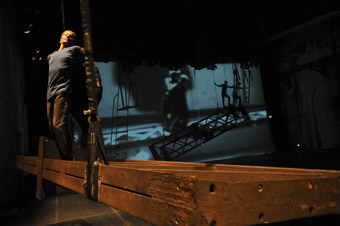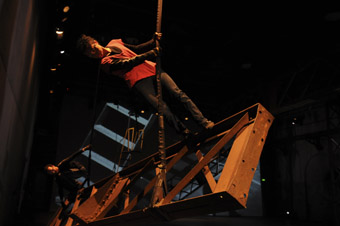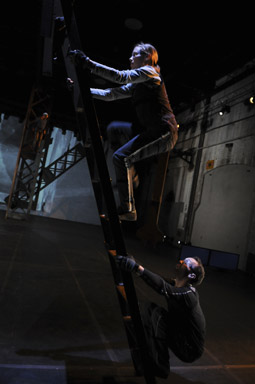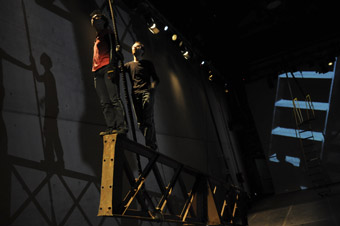dancing heavy metal
pauline manley: de quincey company, run – a performance engine

Peter Fraser, Linda Luke, Run: a
performance engine
DE QUINCEY COMPANY TRAINING IS SO CELLULAR, SO DEEPLY MUSCULAR, SO FULL OF BONE AND BLOOD, THAT THERE IS NO ESCAPE FROM FULL COMMITMENT TO TASK. BODY WEATHER PRACTICE MAKES ATMOSPHERIC PERFORMANCE: THICK WITH THE HEAT OF BODIES ENGAGED EVEN TO QUANTUM LEVELS.
Entering a DQC performance is to enter a world already ripe with the design and breath of what is to happen. Run did not feel like that. In a huge space, splintered, fractured and cold, dancers were initially held at a distance, making shape against lines of steel and pendulous sculpture. Surprisingly choreographic, Run did not immediately grab my guts. But amidst a harsh landscape a gentle build began to gather. Eventually, my stomach lurched with the drops and swings of heavy scaffold and vulnerable flesh, my cheeks pinked up with a familiar and sympathetic heat. No longer dancing from their skin and shape Tom Davies, Victoria Hunt, Linda Luke and Peter Fraser began to dance from their intestines and their sweat: ah, here it is.

Tom Davies, Victoria Hunt, Run: a performance engine
Kudos to musician Dale Gorfinkel who came from Melbourne at a ‘moment’s notice’ to replace the ill Jim Denley. He sits on the floor with his back to the audience. Before him is strewn a miniature ‘orchestra’ of detritus: broken polystyrene, balls, tubes and all manner of unrecognisable gadgets. The sounds he creates from this barnyard of objects are often gentle, sitting below the surface of the action, only occasionally lashing out into rips and screeches. Sound itself is made apparent and performative by the various ways it enters flesh: ringing, vibrating, stinging, humming, droning. Sound hangs, lingers and shoots; sometimes funny or ominous, sometimes rhythmic and then almost invisible in its subtlety. Gorfinkel rattles, rings, dongs, chimes, bubbles, taps, vibrates, flicks and buzzes. When this music disappears it is only to reveal a distant but persistent hum coming from a somewhere, a bass line to his band and an archetypal comment on a world made of scaffolding.

Linda Luke, Tom Davies, Run: a performance engine
photo Heidrun Löhr
Linda Luke, Tom Davies, Run: a performance engine
Linda Luke creates the opening image of a woman trapped in steel. She shifts her metal encased head in delicate axial glides that will break the fusion and start this hanging sculpture swinging. Throughout, this hunk of weight will turn, twist and sway, making visual the forgotten forces of gravity, weight, girth, solidity, steadiness, lift, fall, recovery, support, strength, thickness. The ebb and flow of energy meeting mass is made metallically graceful.
Sitting inside this beauty is the danger. These strong muscled dancers trust completely the ropes from which the mammoths hang. They ride, weave and duck in smooth timing, loving the steel that could smash and wither. Small gasps escape audience mouths as a scaffold flips and drops, taking bodies with it. Straight lined hunks of iron swing across my eyes, making arcs. Dancers jump over creaking metal carousels, which in their oncoming certainty crack, groan and grind out irresistible rhythms only to swing themselves into silence.

Victoria Hunt, Tom Davies, Run: a performance engine
photo Heidrun Löhr
Victoria Hunt, Tom Davies, Run: a performance engine
Feeling the mobile weightiness of such large sheets of metal was moving. And the ride the dancers took on them was titillating in its peril and satisfying in its accomplished ease. The program states that this “6 tonne dramaturgy” allowed the performers to “fly the space”. Hmmm, not so sure. ‘Flight’ is lift, take off and soar and Run was far more gravitational than this. Run was more earth than sky, more bowel than wing. Bounded groundedness was its thing.
In the mix with the dancers’ surfing on the laws of physics was the mediating technology. Live feed cameras created huge grey ghosts from coloured performers, making shadows dance on shadows of shadows, layering performing multiplicities in the same instance. Close-ups of steel revealed abstractions of monochromatic texture and pattern. Screens, hidden before, emerge, one after the other, revealing doorways of light. These are entrances to a moving stream of manipulated live images, smearing action across virtual depth as a beam of light is smashed into rays across the floor.
Production is performed as Travis Hodgson and Emmanuela Prigioni, sit on shinier, more modern scaffolds, creating worlds of light and video image. The roof and walls of CarriageWorks Bay 20 become sky in this “the scaffolding of the world”. So, so, so much to see, everything is interesting.
Do the dancers get lost in all of this density? Sometimes. But this is a sensible swamping to render them part-of; perhaps a gang of crazy bridge builders working in a landscape so much bigger than themselves. They dance in solos, duets, trios but rarely foursomes. They hug, fight, hang and laugh. They speak text that somehow seems like light relief. Walking on steely air, they slide down ladders, tangling with each other. Victoria Hunt is hurled and flipped by an invisible tormentor so violently I feel hurt. At denouement I am tired, over-stimulated, hot and twitching. It only ends when Gorfinkel stops and then there is that gap, where the audience is silent and slightly stunned: sitting inside that bassline hum that never went away.
–
De Quincey Company, Run: a performance engine, direction, choroegraphy Tess de Quincey, performers Tom Davies, Peter Fraser, Victoria Hunt, Linda Luke, sculptural installation and rigging Garnett Brownbill, Bernie Regan, lighting design Travis Hodgson, music Dale Gorfinkel, video artist Emmanuela Prigioni, media installation John Tonkin; Performance Space, CarriageWorks, Sydney, Aug 20-29
RealTime issue #93 Oct-Nov 2009 pg. 36






